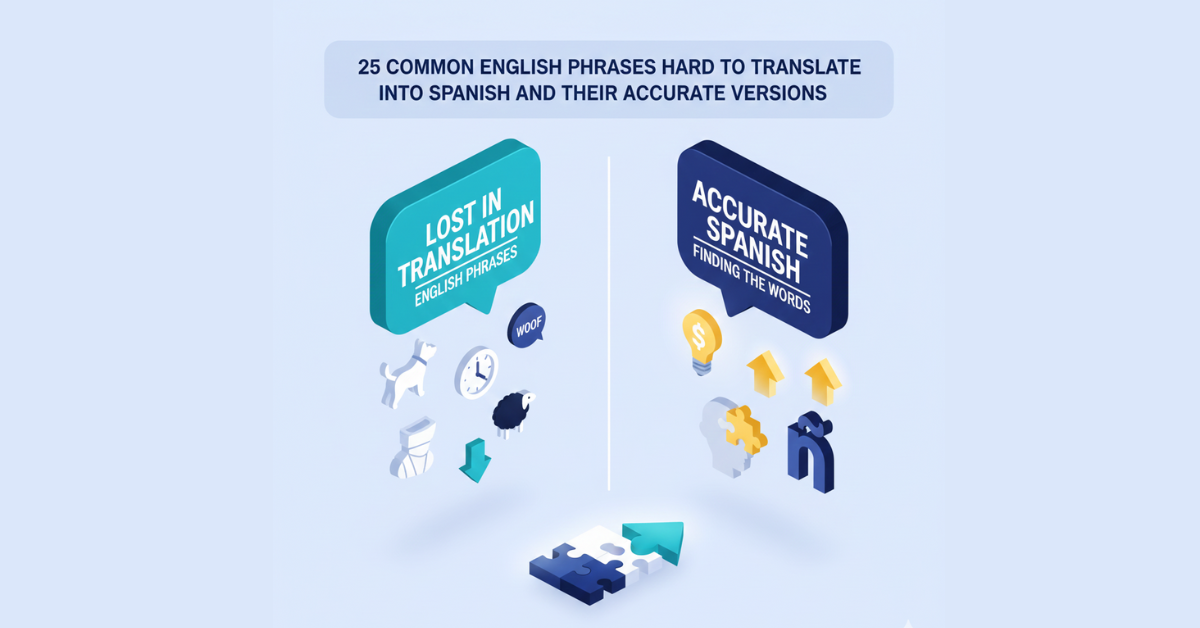The Cost of Misinterpretation in Business
Feb 08, 2024, Nishi SinghMisinterpretation in business can have significant consequences. It can lead to misunderstandings, conflict escalation, financial losses, and missed opportunities. In this blog, we will explore the various forms of misinterpretation, everyday examples of misinterpretation, as well as the risks and impacts associated with it. We will also discuss strategies for mitigating misinterpretation and the value of proper interpretation in business. By understanding the cost of misinterpretation and implementing effective communication strategies, individuals and organizations can improve their communication skills and avoid the negative outcomes of misinterpretation. Now, let's delve into the significance of misinterpretation in business communication and the forms it can take.
The Significance of Misinterpretation
Misinterpretation is the act of assigning an incorrect meaning to something. In the context of business, misinterpretation can occur at various levels, including linguistic, cultural, and nonverbal cues. It is essential to recognize the significance of misinterpretation as it can lead to miscommunication, conflicts, and financial losses. Understanding the causes and impacts of misinterpretation can help individuals and organizations navigate the complexities of business communication more effectively, leading to better outcomes and improved relationships. Let's explore the various forms of misinterpretation in more detail.
Forms of Misinterpretation: Linguistic, Cultural, Nonverbal Cues
Misinterpretation can result from linguistic differences, cultural nuances, and misinterpretation of nonverbal cues. Due to linguistic variation, words or phrases can be misunderstood, leading to miscommunication. For example, the word "gift" in English can mean both a present and a talent, but misinterpretation can occur if the intended meaning is not clear.
Culture plays a significant role in misinterpretation, as different cultures may have varying interpretations of words and meanings. Idioms, colloquial expressions, and gestures can be misinterpreted if cultural differences are not taken into account.
Nonverbal cues, such as body language and facial expressions, can also be misinterpreted. A simple gesture or facial expression can be perceived differently, leading to misunderstanding and miscommunication.
By understanding the various forms of misinterpretation, individuals can be more mindful of the potential for miscommunication and take steps to prevent it.
Everyday Examples of Misinterpretation
Misinterpretation is not limited to business contexts; it can occur in everyday conversations and interactions. Here are some everyday examples of misinterpretation:
- During negotiations, misinterpretation of terms or intentions can lead to misunderstandings and failed agreements.
- In discussions, misinterpretation of ideas or statements can result in confusion and misunderstanding of the intended message.
- Even in casual chats, misinterpretation can happen, causing miscommunication and potential conflict.
- It is essential to recognize the prevalence of misinterpretation in daily life and be proactive in improving our communication skills to avoid these pitfalls.
- Misinterpretation can lead to unnecessary conflicts and confusion.
- It hinders effective collaboration and teamwork.
- Misinterpretation can strain relationships, causing misunderstandings.
- It can occur in personal conversations, leading to emotional disconnection.
Risks Associated with Misinterpretation
Misinterpretation in business and professional settings can have serious risks. Poor communication resulting from misinterpretation can lead to delays, errors, and misalignment of goals. It can hinder transactions, negotiations, and strategic decisions, impacting the overall success of the organization. Furthermore, misinterpretation can have legal consequences, strain interpersonal relationships, and undermine academic research. Recognizing and addressing the risks associated with misinterpretation is crucial for individuals and organizations to thrive in a globalized and diverse business environment.
Misinterpretation in Business and Professional Settings
In the fast-paced and complex world of business, misinterpretation can have significant consequences. Inaccurate interpretation of information, instructions, or expectations can lead to miscommunication, delays, and errors. It can affect the efficiency of transactions, hinder negotiations, and create misunderstandings among colleagues and clients.
Effective communication is essential for successful collaboration, innovation, and problem-solving. Misinterpretation can hamper these essential processes, leading to inefficiency, decreased productivity, and missed opportunities.
To mitigate the risks associated with misinterpretation in business, clear and concise communication, active listening, and cultural sensitivity are crucial. In the next section, we will explore the legal, interpersonal, and academic implications of misinterpretation.
Legal Consequences of Misinterpretation
Misinterpretation can have legal ramifications, especially in contractual agreements and legal proceedings. In contracts, misinterpretation of terms, clauses, or conditions can lead to misunderstandings, disputes, and financial losses. Testimonies and evidence may be misinterpreted in legal proceedings, affecting the verdicts and outcomes of cases.
Legal misinterpretation can result in unjust outcomes and lengthy legal battles, prolonging the resolution of disputes and adding additional costs. To mitigate the legal consequences of misinterpretation, it is crucial to ensure clear and unambiguous communication, seek legal advice when necessary, and have a thorough understanding of the language and terminology used in legal documents.
Misinterpretation in Interpersonal Relationships
Misinterpretation is not limited to business settings; it can also have a significant impact on interpersonal relationships. Misunderstandings, misconstructions, and misinterpretation of words, actions, or intentions can strain relationships, causing emotional disconnection and conflicts.
In personal conversations, misinterpretation can happen when the intended meaning of words or gestures is not accurately understood. It can lead to hurt feelings, resentment, and a breakdown of trust and communication.
Clear and open communication, active listening, and empathy are essential in preventing misinterpretation and maintaining healthy interpersonal relationships. By being mindful of the potential for misinterpretation and actively working towards clear communication, individuals can nurture and strengthen their personal connections.
Misinterpretation in Academic Research
Misinterpretation can also have significant implications in academic research. Inaccurate interpretation of data, sources, or theories can lead to flawed conclusions, misleading publications, and a waste of time and resources. The validity of research findings can be compromised, impacting the overall quality and credibility of the research.
To mitigate the risks of misinterpretation in academic research, researchers should prioritize clarity, precision, and transparency in their communication. It is crucial to thoroughly understand the sources, theories, and methodologies used, as well as to seek feedback and validation from peers and mentors.
Impact of Misinterpretation
Misinterpretation can have wide-ranging impacts, affecting both individuals and organizations. It can lead to conflict escalation, loss of trust and credibility, financial losses, and missed opportunities. Understanding the potential consequences of misinterpretation is essential for fostering effective communication and minimizing the risks associated with miscommunication.
In the following sections, we will explore the specific impacts of misinterpretation, including conflict escalation, loss of trust and credibility, financial losses, and missed opportunities. Additionally, we will discuss strategies for mitigating misinterpretation and the value of proper interpretation in business communication.
Conflict Escalation due to Misinterpretation
Misinterpretation can be a catalyst for conflict escalation. What may begin as a simple miscommunication or misinterpretation of words or intentions can quickly escalate into heated arguments, strained relationships, and irreversible damage.
Addressing misinterpretation early on is essential to prevent conflict escalation. By clarifying intentions, actively listening, and seeking feedback, individuals can minimize the chance of misinterpretation leading to conflicts. Open and honest communication, empathy, and a willingness to resolve misunderstandings can help bridge the gap and maintain positive relationships.
Loss of Trust and Credibility
Misinterpretation can result in a loss of trust and credibility between individuals and organizations. When words or actions are misinterpreted, it can lead to misunderstandings, misconstruction, and miscommunication, eroding the foundation of trust.
Trust is the cornerstone of any successful relationship, whether it is between colleagues, business partners, or customers. Misinterpretations can create disconnection, doubt, and a lack of confidence in the accuracy and reliability of the communication.
To prevent the loss of trust and credibility, clear and concise communication, active listening, and open dialogue are essential. By addressing misinterpretation proactively and transparently, individuals and organizations can rebuild trust and maintain strong relationships.
Financial Losses due to Miscommunication
Misinterpretation can have significant financial implications for businesses. It can result in misinformation, misunderstanding of critical information, and miscomprehension of financial details. The cost of misinterpretation can impact the profitability of the business, leading to financial losses.
For example, misinterpretation of financial terms and projections can lead to misinformed decision-making, resulting in the loss of valuable opportunities. Inaccurate translation of financial documents or misinterpretation of foreign markets can also lead to missed revenue streams and decreased profitability.
To minimize the risk of financial losses due to miscommunication, clear and accurate interpretation of financial information, the use of professional translators, and regular communication and collaboration with financial experts are essential.
Missed Opportunities due to Misinterpretation
Misinterpretation can also result in missed business opportunities. When ideas, proposals, or new words are misinterpreted, the potential benefits and opportunities they present may be overlooked or dismissed.
In the fast-paced business world, missed opportunities can have significant consequences, from the loss of new clients or partnerships to the inability to capitalize on emerging trends or market demands. The cost of misinterpretation, in terms of missed opportunities, can hinder growth, innovation, and the overall success of the business.
By fostering clear explanations, active listening, and cultural sensitivity, individuals and organizations can enhance their ability to seize opportunities and thrive in a competitive marketplace.
Mitigation Strategies for Misinterpretation
To address the risks and impacts of misinterpretation, various strategies can be employed. Active listening, clarification and paraphrasing, cultural sensitivity, and the use of clear and concise language can help mitigate misinterpretation in communication.
In the following sections, we will explore the importance of each of these strategies and how they can be applied to improve communication skills and minimize the likelihood of misinterpretation. By incorporating these strategies into our daily communication practices, we can foster clearer, more effective communication and avoid the costly consequences of misinterpretation.
Importance of Active Listening
Active listening plays a vital role in reducing misinterpretation and enhancing communication. By fully focusing on the speaker, withholding judgment, and providing verbal and nonverbal cues of attentiveness, the listener can better understand the intended meaning of the speaker. It helps prevent misinterpretation of ideas, concepts, and translation direction.
Role of Clarification and Paraphrasing
Clarification and paraphrasing are essential techniques that can aid in ensuring the accurate interpretation of messages. Clarification involves seeking additional information, confirming understanding, or asking for explanations when a message is unclear. Paraphrasing involves restating the speaker’s words in one's own words to confirm the accurate interpretation of the message. By actively utilizing these techniques, misinterpretation can be minimized, and effective communication can be fostered.
Cultural Sensitivity and Awareness
Cultural sensitivity and awareness are vital in avoiding misinterpretation, especially in a globalized business environment. Understanding cultural nuances, embracing diversity, and being aware of the impact of different cultural practices and customs on communication can prevent misunderstanding and misinterpretation of words, expressions, and translation direction.
Use of Clear and Concise Language
Using clear and concise language is essential to minimize misinterpretation. Clarity in expression and the usage of language prevents misconstruction and reduces the chances of misinterpretation. Being mindful of essential British English or essential American English grammar, verb usage, and word choices can enhance the clarity of communication and reduce the risk of misinterpretation. Clear explanations, avoiding jargon, and using simple language accessible to all parties can foster a deeper understanding and promote effective communication.
Seeking Feedback and Validation
Seeking feedback and validation is an essential aspect of effective communication and the prevention of misinterpretation. By actively inviting others to provide their interpretation of the message, seeking clarification, and verifying the accuracy of the interpretation, misinterpretation can be minimized. Feedback and validation allow for the identification of potential misinterpretations and the opportunity to rectify them, ultimately fostering clearer, more accurate communication.
The Value of Proper Interpretation in Business
Proper interpretation of information, ideas, and translation direction adds value to business communication. It enhances the accuracy, clarity, and freedom of translation of the intended meaning, facilitating effective communication among individuals, teams, and organizations. Proper interpretation enables the successful conveyance of new ideas, word lists, and essential American English or essential British English usage, promoting better understanding, collaboration, and innovation. In the following section, we will explore case studies that highlight successful interpretation, showcasing the positive outcomes of proper interpretation in business.
Case Studies Highlighting Successful Interpretation
Case studies in various industries demonstrate the value of proper interpretation, including increased sales, improved customer satisfaction, and the avoidance of misinterpretation-related losses. Let's explore some examples of successful interpretation:
- A tech company successfully entered a new market by accurately interpreting cultural nuances, allowing the development of culturally relevant products and marketing strategies.
- A multinational corporation avoided costly misinterpretation-related legal battles by hiring professional interpreters to ensure accurate interpretation during negotiations and contract agreements.
- An online retailer improved customer satisfaction by providing clear explanations and translation direction, minimizing misinterpretation of product details and shipping information.
- These case studies highlight the importance of proper interpretation in business and the positive impact it can have on various aspects of an organization's operations.
How can you apply these strategies to improve your communication skills?
Improving communication skills requires a conscious effort to apply the strategies discussed. Here are some practical ways to apply these strategies:
- Practice active listening: By giving full attention, maintaining eye contact, and paraphrasing to confirm understanding, you can enhance your listening skills and minimize misinterpretation.
- Use clear and concise language: Focus on being clear, avoiding jargon, and using words that are accessible to others. Be aware of essential American English or essential British English usage and word lists when communicating, ensuring effective translation direction and reducing misinterpretation.
- Cultivate cultural sensitivity and awareness: Learn about different cultures, their values, communication styles, and traditions. Adapt your approach accordingly to minimize misinterpretation and foster cross-cultural understanding.
- Seek clarification and paraphrase: When in doubt, ask for clarification or rephrase the information in your own words to confirm understanding. This can help prevent misinterpretation and ensure accurate interpretation of the message.
- Actively seek feedback and validation: Encourage others to provide their interpretation of your message and verify the accuracy of their interpretation. This feedback loop can lead to clearer, more effective communication and minimize misinterpretation.
- By incorporating these strategies into your daily interactions and communication, you can improve your communication skills, reduce the risk of misinterpretation, and foster better understanding, collaboration, and relationships.
Frequently Asked Questions
What are some common causes of misinterpretation in business communication?
Misinterpretation in business communication can arise for various reasons, including:
- Language barriers can lead to misinterpretation, especially when parties do not have a strong command of the language being used.
- Different cultural norms and customs may cause confusion and misunderstandings, affecting the interpretation of words, gestures, and translation direction.
- Lack of clarity in communication, such as vague or incomplete instructions, can lead to misinterpretation.
- Differences in communication styles, such as direct vs. indirect, can contribute to misinterpretation if the intended meaning is not correctly understood.
- To mitigate misinterpretation, it is essential to communicate clearly, consider cultural differences, and seek clarification when needed.
Are there any strategies for preventing misinterpretation in business communication?
Several strategies can help prevent misinterpretation in business communication:
- Use clear and concise language, avoiding jargon or complex terms.
- Repeat back what you have heard to confirm understanding, especially in important or complex discussions.
- Provide context and background information when communicating critical messages.
- Consider cultural differences and the potential for language barriers when communicating with international partners.
- Seek professional translation services or use online resources to verify the meaning, current usage of the word, and example sentences in the relevant context.
- By proactively implementing these strategies, individuals can minimize the risk of misinterpretation and foster effective communication in the business environment.
Conclusion
Misinterpretation in business can have significant consequences. From linguistic and cultural misinterpretations to miscommunication in professional settings, the risks associated with misinterpretation are vast. It can lead to conflict escalation, loss of trust and credibility, financial losses, and missed opportunities. To mitigate misinterpretation, it is crucial to practice active listening, seek clarification, be culturally sensitive, use clear language, and seek feedback. Proper interpretation in business can lead to successful outcomes, as seen in various case studies. By applying these strategies, you can improve your communication skills and avoid the costly impact of misinterpretation. For more information or to get quotes for interpretation services, contact us today.






